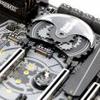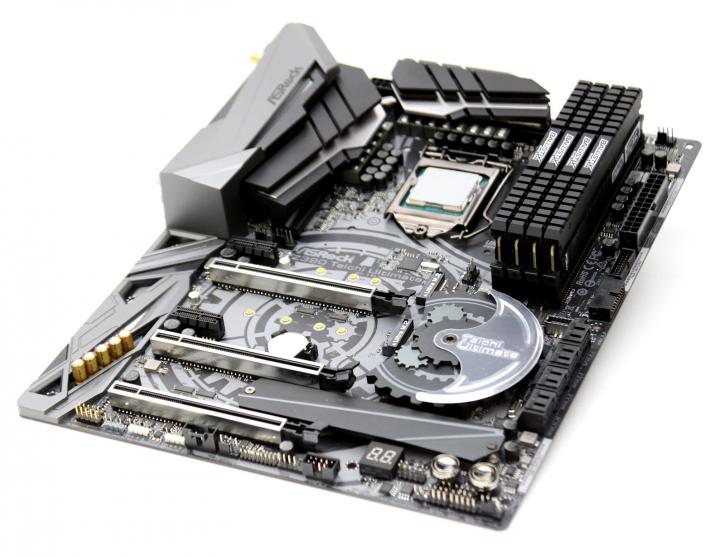Final Words & Conclusion
Conclusion
She's a beauty alright!, ASRock did really well with the Taichi Ultimate. It might be the first 299 USD Z390 motherboard that I find worth the money. And that is mainly because of the three M.2. slots, AC wifi, eight SATA ports and then triple Ethernet jacks with one of them being an awesome 10 Gbps connector, nice.
At default settings and after having tested a dozen boards, the performance all is more or less the same, as well as the features. Big plusses for the motherboard are the integration of three M2 slots and Ethernet functionality. Performance overall we cannot complain about. We did have higher thane expected temperatures during overclocking though, in hindsight, I might have had a wrong pump setting. The board has a good cooled VRM design, the thermal images have been impressive to watch alright. Z390 overall remains to be a bit of a simple release, it is a small step upwards with merely adding native USB 3.1 Gen 2 and WIFI, that and it's better optimized on the VRM area to deal with the new 8-core processors. However, the motherboard manufacturers always seem to improve and excel on what is available. Aesthetically speaking I think this board is one of the best motherboards out there, just look at that.
Power consumption
With this eight cores and sixteen threads proc you get a 95 Watt TDP processor. With the system at idle with a GeForce RTX 2080 Ti installed / 16 GB memory / SSD and the Z390 motherboard, I hovered at roughly 60~65 Watts in IDLE. That's okay, the load values are okay as well but definitely higher. When we stressed the processor 100% run we reach roughly 200 Watts with this 8-core part. That's the entire system. That is on the high side alright. Then again, does anyone actually care about it when you get performance metrics like shown today?
DDR4 Memory
For Coffee Lake-S (8th and 9th Gen Intel procs) and DDR4 we always say, volume matters more than frequency. A 3,200 MHz kit, for example, is more expensive and does offer better bandwidth but the performance increase in real-world usage will be hard to find. Unless you transcode videos over the processor a lot. As always, my advice would be to go with lower clocked DDR4 memory with decent timings, but get more of it. Don't go for 8 GB, get two or four DIMMs and in total a minimum of 16 GB. The reason we test at 3200 MHz is simple, we do the same for AMD Ryzen and want to create a fair and equal playing ground for both. 3200 MHz is, however, a very nice equilibrium for both processor brands.
Performance & tweaking
Once tweaked we noticed that the eight cores like a bit of extra voltage, we expect all-core tweaks in the 5.1~5.2 GHz marker to need ~1.38 Volts on the processor. While that does increase power consumption, it wasn't something that scared me away. Some platforms will and procs will also be able to manage a lower voltage. Again, we have been using an ES sample so I cannot say anything conclusive on the final retail products (these might run a tiny bit cooler). The infrastructure that Z390 offers is easy to use, you increase the CPU voltage and multiplier and you are good to go. Another plus for the Intel platform is that over the years they have been able to refine their memory controllers, pop in anything XMP 2.0 and you have a 90% chance it'll work straight out of the box with very fast memories. Mind you that all our tests are performed at 3200 MHz DDR4, similar to Ryzen and Threadripper to remain objective and for fair play on both sides. realistically though, Ryzen is more memory frequency dependent in gaming than Intel is.
Final words
The first paragraph of this page already gave it away, I really like this motherboard. The 299 USD price tag is steep, but this round you can see where that money went into, eight SATA3 ports, triple M2, triple Ethernet jacks with one Aquantia 10 Gbps connector as well as proper AC wifi. I'm lovin that. Looks matter, and the looks for this board are just great. Especially once powered up, the subtle LED elements really make the magic happen. There's little to nothing complain really, fast WiFi, fast Ethernet, support for SLI and CrossFire, and an ALC1220 audio codec with s/pdif and three M2 slots. At the time of writing it looks that this mobo is going to cost € 299,- with a similar figure in USD. ASRock did it right with the Taichi Ultimate from both a hardware and aesthetic design, this easily is ranking in my personal top three Z390 boards and worthy of a top pick award.
Handy related downloads:
- Sign up to receive a notice when we publish a new article
- Or go back to Guru3D's front page



